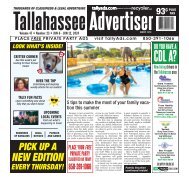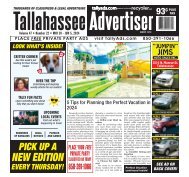Create successful ePaper yourself
Turn your PDF publications into a flip-book with our unique Google optimized e-Paper software.
THETRUCKER.COM NATION<br />
OCTOBER 2022 • 7<br />
As rail strike loomed in mid-September, Biden stepped in to help avert it<br />
THE ASSOCIATED PRESS<br />
WASHINGTON — As of this writing in mid-<br />
September, rail companies and their workers<br />
had reached a tentative agreement to avert a<br />
nationwide strike that could have shut down<br />
the nation’s freight trains and devastated the<br />
economy less than two months before the<br />
midterm elections.<br />
President Joe Biden announced the deal,<br />
which emerged from a marathon 20-hour<br />
negotiating session at the Labor Department and<br />
came just one day before the threatened walkout.<br />
“This agreement is validation of what I’ve<br />
always believed — unions and management can<br />
work together … for the benefit of everyone,”<br />
Biden said at the White House.<br />
The deal, which includes a 24% pay raise, will<br />
go to union members for a vote after a cooling-off<br />
period of several weeks.<br />
American Trucking Associations President<br />
and CEO Chris Spear congratulated the nation’s<br />
freight railroads and their unions on reaching<br />
a deal and averting a potentially economically<br />
catastrophic strike.<br />
“Our supply chain is entirely interdependent,<br />
making the potential for a nationwide rail<br />
stoppage a serious threat to our nation’s<br />
economic and national security,” Spear said.<br />
“We applaud both sides for reaching a tentative<br />
agreement that averts this outcome and permits<br />
our supply chain to continue climbing out of this<br />
COVID-induced rut.”<br />
Earlier in the month, Spear sent a letter to<br />
Capitol Hill warning of the risks of a nationwide<br />
rail strike.<br />
Mike Steenhoek, executive director of the<br />
Soy Transportation Coalition, also praised the<br />
tentative deal.<br />
“We are extremely pleased both sides were<br />
able to arrive at an agreement,” he said. “Our<br />
nation’s railroads are integral to the success of<br />
the American farmer. Without cost-effective,<br />
reliable rail service, so much of what farmers<br />
produce will never connect with our domestic<br />
and international customers.<br />
Biden made a key phone call on the evening<br />
of Sept. 14 to Labor Secretary Marty Walsh<br />
as negotiators were talking and being offered<br />
Italian food for dinner, according to White House<br />
officials who insisted on anonymity to discuss the<br />
conversations.<br />
On speakerphone, the president urged both<br />
sides to get a deal done and to consider the<br />
harm that a shutdown would inflict on families,<br />
farmers and businesses, the officials said.<br />
The five-year deal, retroactive to 2020, also<br />
includes $5,000 in bonuses. The railroads agreed<br />
SEE RAIL ON PAGE 21<br />
AP Photo/Gene J. Puskar<br />
Norfolk Southern locomotives are moved in the Conway Terminal in Conway, Pennsylvania, Thursday, Sept. 15.<br />
INTERMODAL cont. from Page 3<br />
into the facility. Some facilities are run very<br />
efficiently and keep wait time as short as<br />
possible; others, not so much.<br />
Maintenance of chassis can be a problem,<br />
too. Chassis are often owned by the shipping<br />
line and rented to the carriers who pull<br />
them. Carriers are often reluctant to repair<br />
a chassis they don’t own, especially when<br />
reimbursement from the chassis owner<br />
takes a long time — or doesn’t happen at all.<br />
Ports and rail yards often deal with<br />
maintenance by inspecting trucks that are<br />
on their way out of the facility. There is often<br />
a long line for inspection and another wait<br />
if repairs are need, so some drivers would<br />
rather take their chances if they haven’t<br />
seen a visible problem with the chassis.<br />
When drivers have to hook up to a chassis<br />
first, they may have difficulty finding one<br />
in good repair. Drivers often would rather<br />
deliver the chassis to the facility with a flat<br />
tire or a mechanical issue than take the time<br />
to get it fixed on the road, especially if the<br />
distance isn’t very far.<br />
Drivers can also be unkind to one<br />
another when it comes to chassis. It’s not<br />
uncommon to find a chassis that’s missing<br />
lights, lug nuts or any other item a driver<br />
might have needed to make another chassis<br />
roadworthy.<br />
Other disadvantages of intermodal<br />
trucking include lower compensation than<br />
longer-distance forms of trucking. Since the<br />
U.S. imports much more than it exports, it<br />
can be difficult to find a load returning to<br />
the port for shipment, and deadheading is<br />
often a possibility.<br />
Additionally, since chassis are usually<br />
owned by shipping lines, they can’t be used<br />
to haul containers belonging to another<br />
shipping line unless the two companies have<br />
a cooperation agreement. For example, a<br />
driver may return a chassis owned by Maersk<br />
to the port and need to pick up a different<br />
chassis to haul the next container that’s<br />
owned by another company. Even when<br />
owned by the same company, containers<br />
can be different sizes. For example, a 40-foot<br />
container won’t fit on a chassis made for a<br />
20-foot container.<br />
Another drawback to intermodal is that<br />
drivers often don’t know anything about<br />
the cargo, its weight or how it was loaded.<br />
Paperwork, such as bills of lading, are<br />
often created in another country, where<br />
people speak a different language and use<br />
different measurement methods — all of<br />
which may not translate perfectly. Often,<br />
cargo information such as weights is more<br />
of an estimation than reality. Containers are<br />
sealed, so drivers usually can’t get a look at<br />
how cargo is loaded, making it difficult to<br />
predict if the load is top-heavy or leans to<br />
one side.<br />
Intermodal trucking can be rewarding,<br />
providing steady income and home time<br />
for many drivers, but there are also unique<br />
challenges.<br />
Drivers who are considering taking<br />
on the job would be wise to ask plenty<br />
of questions about potential miles and<br />
income. Speaking with experienced drivers<br />
is a must, since they can provide accurate<br />
information about carriers, customers and<br />
port and rail facilities. It isn’t uncommon for<br />
a driver to have worked for several carriers<br />
in the area, and he or she should be able to<br />
provide information about each. 8<br />
MA<strong>TT</strong>ER cont. from Page 4<br />
that particularly focuses on releasing the<br />
shoulders, underarm area and lower back.<br />
Grab the truck step, bench or bar and sit back;<br />
breathe deep and relax your arms to stretch<br />
deep.<br />
7. Walking is a great way to keep your<br />
lymphatic system working optimally. Lack of<br />
movement is one of the biggest challenges<br />
our lymphatic system faces, and every minute<br />
counts. Walk in place, add an extra lap about<br />
your truck or walk a lap around the parking<br />
lot — it all adds up.<br />
Finally, don’t forget to hydrate. Your<br />
lymphatic system and circulatory system rely<br />
heavily on fluids — not soda or coffee, but<br />
water. As a bonus, try adding a pinch of Celtic<br />
INFLATION cont. from Page 1<br />
just beginning to start downward.<br />
Kenny Vieth, president and senior analyst<br />
at industry forecaster ACT Research, thinks<br />
current conditions may help keep a recession<br />
from being as bad as it could be.<br />
“We believe wage inflation needs to moderate<br />
before the Fed can begin turning away<br />
from tighter monetary policy,” he said in<br />
a recent press release. “As long as the jobs<br />
report remains strong, wage inflation may<br />
prove stubbornly persistent — which could<br />
in turn lead to a more-aggressive-for-longer<br />
rate hike.”<br />
Vieth identified three factors that could<br />
help mitigate a downturn, at least for trucking.<br />
“Carrier profits and profitability were at<br />
record levels in 2021, and contract freight<br />
sea salt for a boost in essential minerals.<br />
As a driver, it may seem difficult to take<br />
care of your health, but a little goes a long way.<br />
Pick just one of the moves above and commit<br />
to doing it every day for a week. The next<br />
week, add a second move; the third week, add<br />
another. You’ll slowly build up a routine that<br />
promotes not just breast health, but your best<br />
health today, tomorrow and for years to come.<br />
Hope Zvara is the CEO of Mother Trucker<br />
Yoga, a company devoted to improving truck<br />
drivers’ fitness and wellness standards. She<br />
has been featured in Forbes and Yahoo News,<br />
and is a regular guest on SiriusXM Radio. Her<br />
practical strategies show drivers how they can<br />
go from unhealthy and out of options to feeling<br />
good again. For more information, visit www.<br />
mothertruckeryoga.com. 8<br />
rates are still expected to rise by high single<br />
digits this year,” he explained. “Vehicle demand<br />
remains healthy, if moderating from<br />
here, with pent-up demand and low inventories<br />
expected to help mitigate the depth of<br />
the downturn.”<br />
And, he warned, requirements for reduced<br />
emissions from diesel engines will<br />
have an impact.<br />
“Finally, some pre buy activity is anticipated<br />
prior to the implementation of CARB’s<br />
Clean Truck mandate, entering a queue already<br />
filled with pent-up demand,” he said.<br />
“States representing about 10% of industry<br />
demand will be adopting CARB mandates in<br />
both 2024 and 2025.”<br />
While the economy is expected to struggle<br />
in the first half of 2023, there will still be<br />
money to be made by carriers and by the<br />
manufacturers who sell them trucks. 8

















